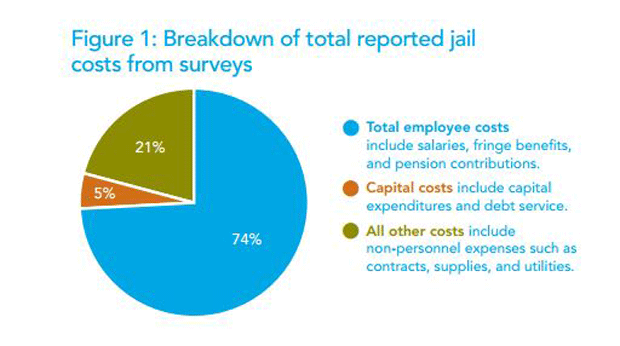How much do jails cost? More than taxpayers think
America's jail population has swelled in recent decades, and so have their costs to taxpayers.
On a daily basis jails hold more than 735,000 inmates, more than triple the number locked up in 1983. Expenses associated with that rise in incarceration have likewise surged, with the U.S. Department of Justice estimating the cost to local communities in 2011 at more than $22 billion. But a new report from the Vera Institute of Justice finds that far underestimates what communities spend on jails.
While every county budgets differently, one example cited in the report is the $1.1 billion spent on jails last year by New York City's Department of Correction. But even that huge sum leaves out the additional $1.3 billion spent for jail employee benefits, health care and education programs for inmates, the report noted. All told, New York City spends $2.4 billion annually on jailing residents.
Because reporting on the cost of jails is often incomplete, that means policymakers and taxpayers may not be aware of the full extent of their financial commitment to their local jails, Vera noted. The problem, however, is not that municipalities or counties are hiding expenses, said Chris Henrichson, lead author of the report.
"Ironically, the problem is an artifact of oversight," he explained. For instance, pension contributions for employees are often handled by another agency.
"By putting pension contributions into a central account, it makes it easier to make those contributions," he said. But the result is that a significant part of those costs aren't included in counties' or municipalities' budgeting for jails, and taxpayers and lawmakers often don't get a full view of the total expense.
For taxpayers and communities, that makes understanding the total costs of jailing people a critical issue, Henrichson said.
"First, there's the issue of transparency," he said. "It's incumbent for governments to be clear on how much they are spending on jails. As counties look to abate mass incarceration, it's important to look at how much is available to reinvest in other programs."
While Americans often use the terms "jail" and "prison" interchangeably, there are several significant differences. Jails are run by counties or local governments, while prisons are run by state governments and the federal government. Inmates in jails are typically held for shorter durations, while prisons are designed for longer-term sentences.
Along with a surge in jail admissions, the average length of stay has also grown longer, Vera said in a report published earlier this year. A typical inmate is now held for 23 days, compared with 14 days three decades ago. All together, that's causing costs to rise, and prompting more communities to question whether there are more efficient ways to spend funds, such as on programs to help people find jobs or get treatment for addictions.
Many jail inmates are there for nonviolent crimes, or are simply too poor to pay court-imposed fines and so end up behind bars for longer periods. Several communities around the U.S. are trying new strategies to deal with non-violent offenses, such as King County, Washington's LEAD program, which enrolls low-level offenders in community-based services.
Another community that has successfully reduced its jail population is Bernalillo County in New Mexico, where the number of inmates has declined to about 1,600, from almost 3,000. The county had been spending millions each year to send inmates to jails in other counties and out of state because its facilities couldn't hold the population, according to the Albuquerque Journal, which noted that the earlier crowded conditions had led to a lawsuit.
"The surest and safest way to save money is to take steps to reduce the jail population," Henrichson said.
Because jails have an inmate population that turns over faster than prison populations, they have an opportunity to make changes on a shorter time-scale, he noted.
"The point we try to drive home is the cost of jail is important to be aware of because it means there is an opportunity here as jails downsize," Henrichson said. "As they shrink, there is money that is available for other services."
